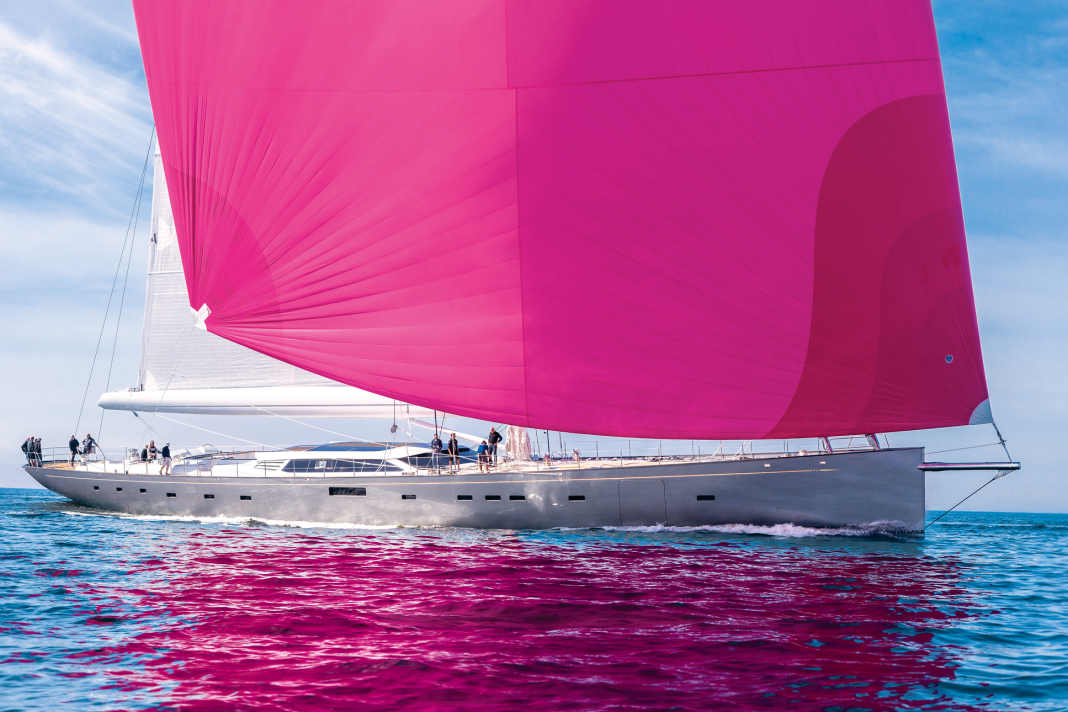





"Three years of planning, three years of construction." Hans Georg Näder described the progress of the "Pink Gin VI" project in a nutshell in mid-May 2017. Näder had invited people to the launch of the largest carbon fibre sloop at the time in Pietarsaari, Finland, in 2018. The almost 54-metre grey hull was launched there.
She was built by Baltic Yachts in Bosund, a few kilometres away. Baltic Yachts is owned by Näder. The owner has also been the shipyard owner here since 2013, and he already knew Baltic Yachts quite well five years ago. The shipyard had already supplied him with "Pink Gin", the Baltic 97 in 1999 and then the 152-footer "V" in 2008.
According to information from Baltic Yachts, owner Hans Georg Näder is currently sailing his "Pink Gin VI" and is also accompanied by an explorer. At the present time the sailing yacht for 27,500,000 euros for sale. In addition to her, Näder's 43-foot yacht and the "Pink Gin Verde" sold. The latter was built in 2021 and is currently moored off the Balearic island of Mallorca.
"Pink gin" has it in and on itself
The Stones fan rocked the seas in 2018 with his sixth "Pink Gin" - the red Stones tongue logo on the fuselage of Näder's Bombardier Challenger is a clear indication of this. And this gin has it all. Näder's sixth sums up the challenges she has overcome, especially the biggest one: "Developing a timeless style, a yacht that suits the owner's usage behaviour, delivers strong performance and looks pleasing at the same time," explains her designer Rolf Vrolijk.
In general, the task was to "learn lessons from the Baltic 152, improve and upgrade it." The new boat shares the sea with a steep stem. "The deck lines and superstructure are based on the predecessor." Vrolijk and Näder have known each other for almost decades. They understand each other. "The new 'Pink Gin' should not be longer than 50 metres in order to be able to moor in ports like Saint-Tropez. Although she now reaches almost 54 metres, she still fits into many harbours," adds Vrolijk.
The improvements include greater dimensional stability: "The increased U-shape of the hull ensures this. We limited the heeling angle to a maximum of 20 to 22 degrees, comfortable yet efficient. Pure regatta yachts are designed for up to 27 degrees." With a ballast of 75 tonnes, "Pink Gin VI" is stiff enough. In addition to the keel box, the hydraulic cylinders and the locking mechanism, the total keel weight of a good 80 tonnes is made up of 56 tonnes for the lead bomb and 18 tonnes for the stainless steel fin. The bomb can be raised from a draught of seven metres and locked at 5.56 metres and 4.50 metres so that it can also be anchored in shallower bays.
"Pink Gin" designed for worldwide travel
The sail plan also plays a role in the performance gain. The developers from Vrolijk's Bremerhaven office Judel/Vrolijk & Co designed it for light Mediterranean winds and long, spacious courses on ocean crossings. "She is primarily designed for worldwide voyages and needs a lot of sail area, which her high slip rig offers." She will reach speeds of around 13 and 14 knots on moderate roomy courses. In light winds, she will not have to rely on the twelve-cylinder MAN engine, which delivers its power to the water via a Hundested gearbox with Hundested propeller.
"The optimum sailing conditions," Vrolijk's team calculated before the launch, "will be at 14 to 16 knots." From 16 knots upwind, the crew reduces the sail area. "Pink Gin VI" uses a genoa in light to medium winds, otherwise a slim and high-cut blade sail and a working jib on the inner stay. There are 1,322 square metres on the cross with mainsail and blade. Space sheets pull 2,593 square metres on the boat with the pink asymmetric monster sail.
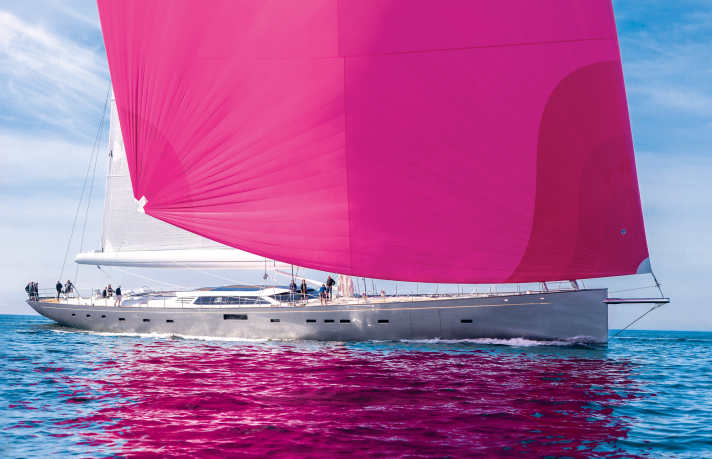
A top speed of 30 knots is possible on these courses. The asymmetric weighs a quarter of a tonne and can no longer be managed with the crew's muscle power. A remote-controlled carbon fibre drum with a diameter of two metres in the forepeak, developed by Baltic, helps with setting and recovering.
Sailing position and yacht steered from the centre cockpit
The young Mallorcan captain Oscar Vallejo steers the sail position and yacht from the centre cockpit - one of three - using one of the two helm stations. The steering system is one of the unusual novelties called the Force Feedback Steering System - an innovation from Baltic Yachts. Despite the rudder pressure on the huge four-metre-deep blade, the helmsman feels only silky-smooth, but relatively increasing and decreasing resistance, as on a small boat in direct contact with the quadrant. Electronic sensors make it possible.
The owner decided on the ergonomics of the deck layout with three cockpits. "It reflects the utilisation," explains Vrolijk. In the aft cockpit behind the boom, the owner and guests can relax and worship the sun, completely separated from the large steering and control station in front. Further forward, the third cockpit is an inviting space with a bar and an open-air dining area.
At anchor, an awning over the boom and two Murano glass candelabras under the boom - designed by the "Pink Gin" interior designers from Design Unlimited and realised by the Parisian lighting specialist Veronese - transform it into a sheltered al-fresco dining salon. Together with floral decorations and potted plants, this large centre cockpit looks like a terrace with a view of the lake all around, with direct access to the first, upper saloon in the deckhouse. This is used for musical entertainment. This is ensured by a self-playing small carbon fibre grand piano from the English piano makers Edelweiss from Cambridge on the port side, a custom-made instrument with bog oak keys.
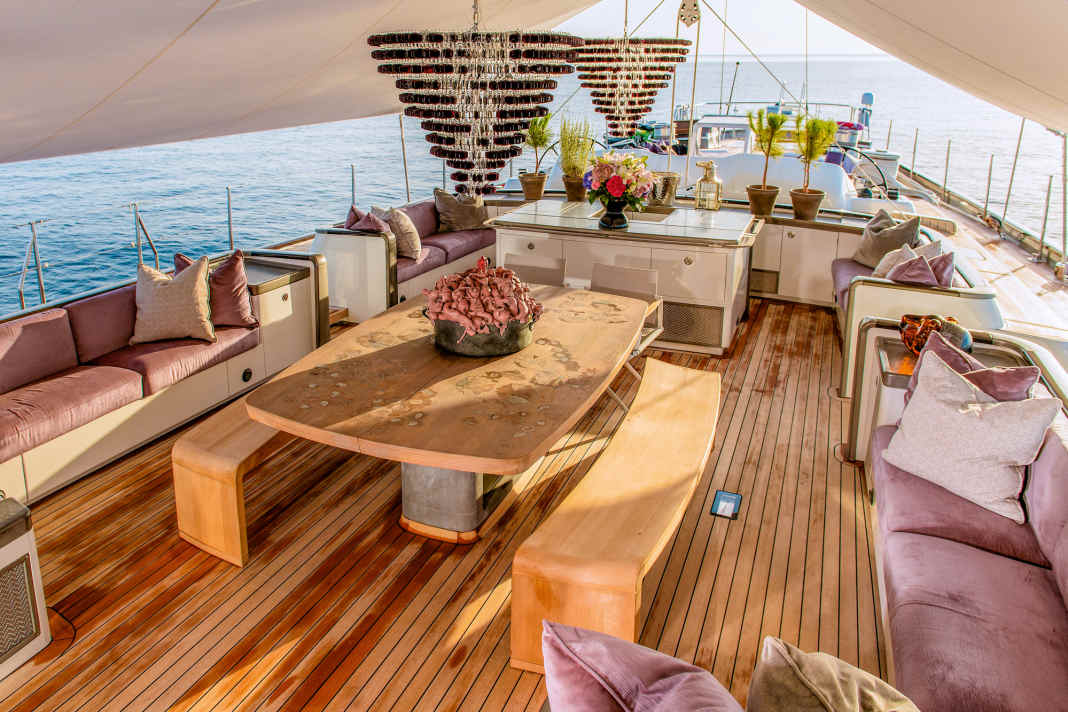



Furnishing the sailing yacht
Opposite, the audience takes a seat on a Chesterfield-style U-shaped sofa with a small dining table, also made of bog oak, to listen to the electronic pianist. The table and piano are illuminated by Baccarat chandeliers and salmon leather-covered columns in the centre of the salon. The Dutchman Marcin Rusak decorated the second dining area two steps down on the port side with dried flowers and foliage inlaid in semi-transparent resin. Hans Georg Näder inherited the chandelier above the table from his "Pink Gin V". He was attached to it. He couldn't let go of the large Vuitton travel crate either; it too had already served on his previous sailing gin palace and forms the centre of the seating area opposite the large dining table.
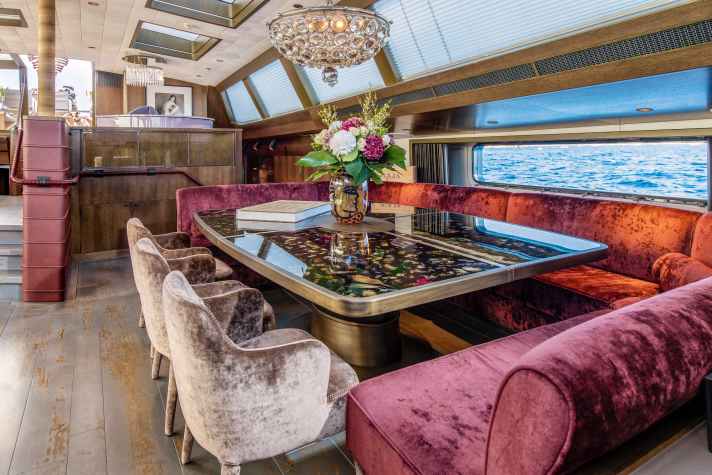
The shipyard itself took care of the smoked oak floorboards in the lounge, painted gold, then silver and then deliberately sanded irregularly to expose the layers in places. This is what precious shabby chic looks like. In front of the salons, the shipyard installed four guest cabins, two of which have double beds and a larger one designed for VIPs.
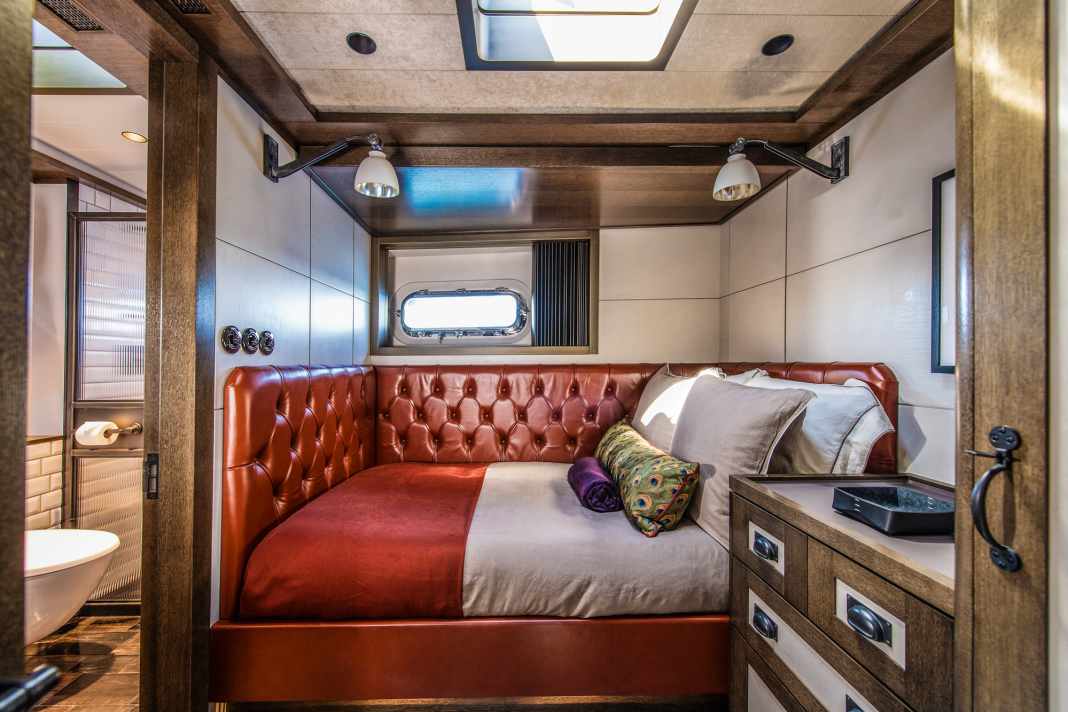


The shipyard installed the owner's suite in the bow. Näder, who is not angry when he reads his professorial title, did not miss out on the highly expensive shabbiness in the bedroom, bathroom and walk-in wardrobe. Silk paintings by Cuban artist Roberto Fabelo flatter the studio, but carefully composed puzzle panels made from the hulls of scrapped Cuban fishing boats emphasise the tongue-in-cheek modesty.
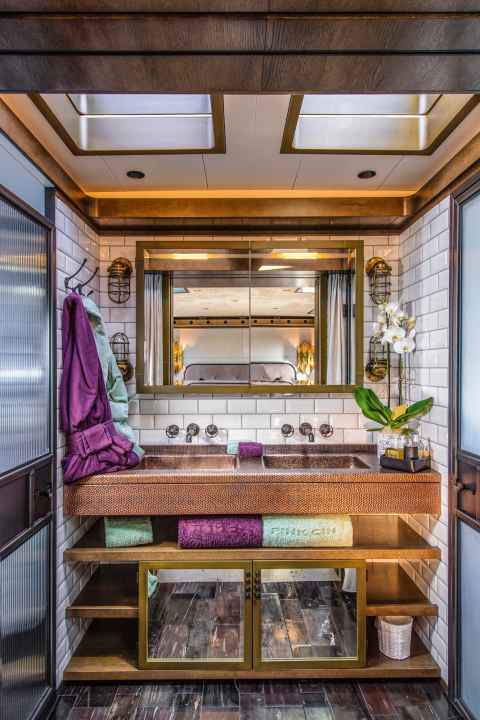
Direct access for guests via balconies
The outstanding elements include two balconies that open like side hatches. "Normally, even on large sailing yachts, everything is first hoisted up onto the deck and then stowed down again," explains Vrolijk. This doesn't just apply to provisions and luggage; why shouldn't guests and crew be able to get to their accommodation directly from land? The hatch on the port hatch allows this. It serves as a shared access point. The crew can find their accommodation directly from here in the stern. The starboard balcony, however, belongs to the owner. The former folds out of the suite next to the king-size bed.
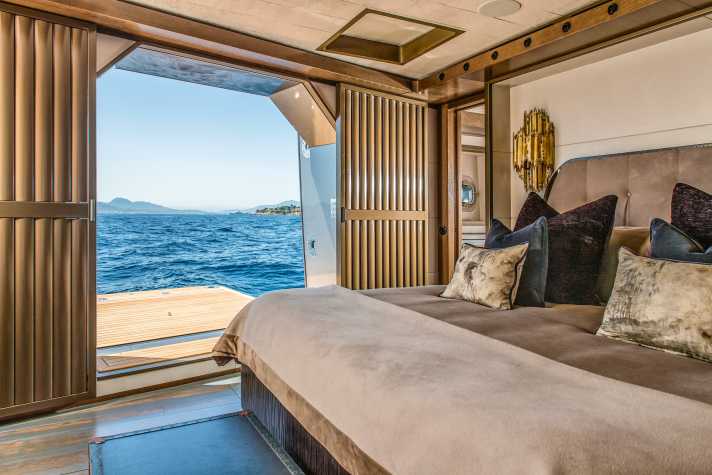
"Pink Gin VI" needs eight crew members for technical operation and hospitality. In addition to the captain, his chief mate and the engineer, two deckhands, two stewardesses and the boss live in the stern. Together with them, friends and family, Hans Georg Näder also enjoyed sailing to Uruguay's coasts towards the end of 2018. After all, "Pink Gin VI" is designed for passages of this kind.
Technical data
- Length over everything: 53,90 m
- Waterline length: 45,27 m
- Width:9,55 m
- Depth: 4,50, 5,56, 7,00 m
- Displacement (empty): 250 t
- Kiel: 80 t
- Material: Carbon fibre composite
- Mast above waterline: 67,90 m
- Mainsail: 755 square metres
- Foresail: 567 and 365 square metres
- Asymmetric: 1,838 square metres
- Mast, rigging: Rondal
- Winches: Rondal
- Motor: MAN V12, 1,000 kW
- Generator: 2x Northern Light
- Fuel: 19.000 l
- Water: 4.800 l
- Control: Baltic Force Feedback
- Bow/stern thruster: Hundested
- Electronics:Furuno, B&G, Sailor
- Construction: Judel/Vrolijk & Co
- Structure:Gurit
- Exterior & Styling: Judel/Vrolijk & Co and Design Unlimited
- Interior design:Design Unlimited
- Classification: GL + LY3
- Shipyard: Baltic Yachts, 2017



